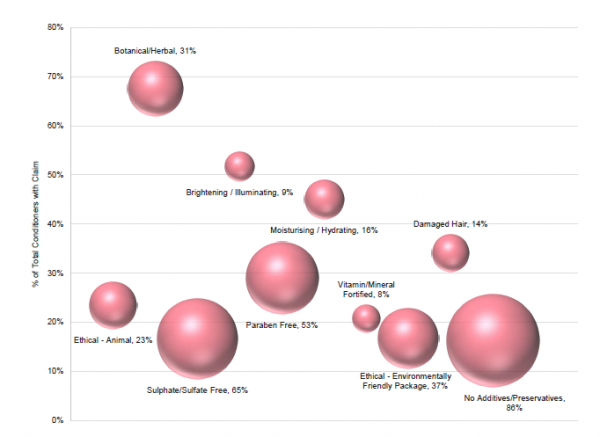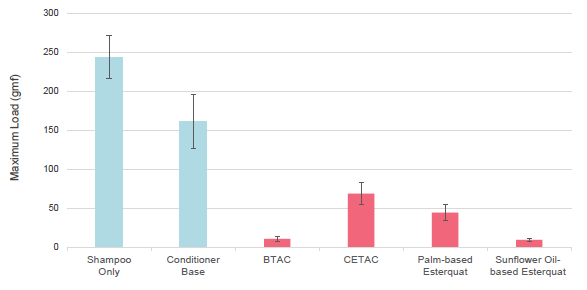Promotional Features
Developing a novel hair conditioner that attracts the consumer
Hair conditioning products are relied upon by women and men around the world to improve the feel, appearance and manageability of their hair. In the last few years, consumers have clamored for conditioners that were not only more effective for their hair, but also better for the environment. Stepan Company recognized this need and the attendant opportunity to develop a modern hair conditioning agent for this growing market.
Market Snapshot
According to Euromonitor International, the hair conditioner market represents 1,358 kMT worth $16.7 billion with a 2.7% compound annual growth rate (CAGR). Of the 1,358 kMT of hair conditioning products globally, approximately 1.5% of the volume is cationic conditioning agents, equal to about 20 kMT.
Mintel data shows that approximately 10,000 new or reformulated hair conditioners were introduced globally from 2016 to 2018. The graph below shows the top 10 claims associated with these products. The Y- axis indicates the percentage of conditioning products that had a specific claim (a conditioner typically has more than one claim) and the size of the bubble indicates the growth of that claim from 2016 to 2018.
Hair Conditioners Launched Worldwide 2016-2018
(bubble size represents % growth in claim popularity)
A Better Cationic
After exhaustive analysis of the hair conditioning market trends, Stepan developed a sunflower oil-based esterquat that delivers on certain performance and sustainability claims more than commonly used cationics.
The most common cationic hair conditioning agents currently used are behentrimonium chloride (BTAC) and cetrimonium chloride (CETAC). As the industry standard for conditioning performance, BTAC is considered the better quaternary for combing and achieving a soft feel. However, In Europe, both BTAC and CETAC have use-level restrictions due to their potential to cause irritation. In addition, these products are very toxic to aquatic life with chronic effects.
Both have environmental impacts that may repel environmentally focused consumers. CETAC is offered in the market as a 30% active solution, meaning a significant amount of transportation energy use and costs are involved in shipping this low-active product. BTAC is offered as a high-active product in the presence of a flammable alcohol, such as isopropanol, which increases transportation costs as a hazardous compound. BTAC is also offered in the presence of long chain fatty alcohols as a high melt-point flake or pellet.
Esterquats are known to be readily biodegradable, mild and less toxic to aquatic life. For decades, this chemical class of cationic agents has been used as fabric softening ingredients, but many of them are animal-derived, which is increasingly unattractive in the personal care market. Although vegetable-derived esterquats are available in the market for fabric softeners, these products do not provide the same premium conditioning performance on hair as BTAC.
Therein was the challenge: to provide a quaternary that performed as expected and left little harm in the environment. Stepan began the development of a cationic hair conditioning agent that could provide the positive environmental and safety profile of esterquats, along with the combing and conditioning performance of BTAC.
The Next-Generation Esterquat
Esterquats are manufactured by reacting a source of long-chain fatty acids with a small tertiary amine then quaternizing with methyl chloride, dimethyl sulfate or diethylsulfate.
Stepan’s product development began with sunflower seed oil, a non-GMO, plant-based raw material grown abundantly in North America. Plant-based esterquats currently on the market are traditionally based on palm oil, but the palm oil carbon chain length is not optimal for hair conditioning. Sunflower oil contains primarily C18 fatty chain moieties and has a high degree of unsaturation: The degree of unsaturation is believed to assist in coating and lubricating the hair for ease of combing. Another benefit of the high degree of unsaturation is that the cationic agent has a much lower melt point, allowing for a high active, low melt point product without the need for flammable solvents.
Methyldiethanolamine is used as the tertiary amine. Using methyl chloride as the quaternizing agent instead of dimethyl sulfate allows for a sulfate-free claim – increasingly important to consumers. The resulting product, STEPANQUAT® Helia, is free of water and is comprised of 95% total cationic and emollient actives. This sunflower oil-based esterquat is considered Derived Natural by ISO 16128 [Standard]. The Natural Origin Index for the product is 0.88. The product has also been tested for irritation potential using Human Repeat Insult Patch Test (HRIPT) methodology and was found to be non-irritating, hypoallergenic and mild to the skin, allowing for more attractive claims. STEPANQUAT® Helia’s unique combination of characteristics that results in overall novel performance and composition is a patent-pending technology.
The graph below shows the result of a combability test using a Dia-Stron instrument that measures the force it takes to pull a comb through a standardized tress of wet hair. To simulate damaged hair, the tress tested is bleached Caucasian hair. The greater the force, the poorer the conditioning performance.
The first bar is shampooed and rinsed hair, unconditioned. The second bar is the base conditioning formulation, without the cationic conditioning agent. Present in the base are fatty alcohols and cellulose thickening agents typically used in hair conditioners to provide viscosity and formulation stability. When 2% active conditioning agent is added to the base, the force needed to comb through hair is significantly reduced by the cationic conditioning agents. CETAC and palm-based esterquats are not premium performers. Only the esterquat based on sunflower oil was able to equal the performance of the leading chemistry, BTAC.
Wet Combability
Dia-Stron testing on Caucasian, slightly bleached hair tresses.
Results are based on the manufacturer's own study, and the manufacturer makes no guarantees as to the accuracy, completeness or adequacy of the information herein.
Today's consumers want more from their hair conditioners. Stepan's novel esterquat for hair conditioning -- STEPANQUAT® Helia -- was developed to fulfill their performance requirements, and their demand for readily biodegradable and lower toxicity ingredients.



